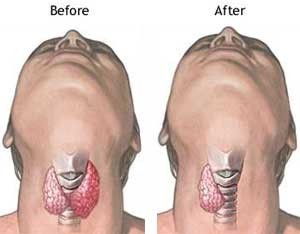We will either recommend removing the entire gland (total thyroidectomy) or part of the gland (subtotal thyroidectomy, partial thyroidectomy, or thyroid lobectomy), depending on the clinical problem.

Partial Thyroidectomy
The thyroid gland overlies the windpipe and is usually located between the thyroid cartilage (Adam’s apple) and the sternum. The gland also overlies the laryngeal nerves which are important for function of the voicebox and the parathyroid glands which regulate the body’s calcium level. There is risk of injury to these structures during surgery and therefore thyroid surgery is only performed by surgeons who understand the anatomy of this area very well.
You will undergo general anesthesia which will be administered through a breathing tube during surgery. Some patients have a sore throat for a few days after surgery because of the presence of the breathing tube and manipulation of the windpipe during surgery. Surgery generally takes 2 to 3 hours depending on the extent of the procedure.
Depending on the extent of your surgery, you may have a small drain placed during surgery which is typically removed the next morning prior to discharge. You will be placed on pain medication and may have to take thyroid hormone replacement or calcium. Pain is usually very manageable after thyroid surgery. Antibiotics are not routinely prescribed unless there is a concern for infection, as they can often cause gastrointestinal discomfort.
We will examine you two weeks after surgery and will examine your incision in order to ensure healing and review your pathology during that appointment. Sutures will usually be placed beneath your skin and will not require removal. After you are healed, your surgeon may have to refer you to an endocrinologist if you require further medical treatment for your underlying thyroid problem or if you require permanent thyroid hormone replacement via an oral supplement.
